An Exciting Recipe for Tuna... (Kassie paddles a Bluefin)
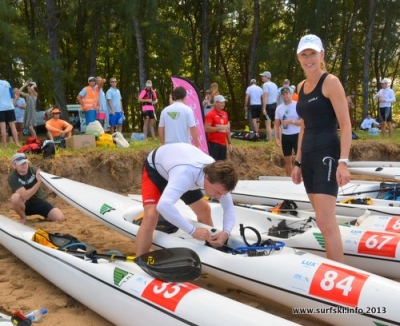 Kassie's pit crew do all the pre-race prep work.
Kassie's pit crew do all the pre-race prep work.
A beginner paddler test pilots the Fenn Bluefin in the 2013 Mauritius Ocean Classic.
As a beginner paddler I confess I don’t give a lot of weight to reviews of entry-level skis by guys who usually paddle a greased toothpick. For starters, I am certain that my definition of "stability" is wildly different to theirs. So here's my (not really a) review of an entry level ski... by an entry level paddler.
Definition: Stability
Most reviews of the more-balanced-ski-for-less-balanced-paddler will contain words along the lines of “Excellent primary and secondary stability”. To many entry level paddlers these words are meaningless. As an insider tip from one beginner to another, “primary stability” relates to the likelihood of you falling off the ski in flat water (and looking like a complete twit) and “secondary stability” refers to the likelihood of you falling off it in water that isn’t completely flat (marginally more dignity attached to this).
And most reviews will usually conclude with something like “Considerably slower than [insert name of expert level ski in the relevant brand]… completely ignoring the fact that an upside down ski is pretty damn slow (unless it is carbon and tumbling across the ocean away from you… and you don’t have a leg rope on… but I digress…)
So it was with a degree of scepticism that I read the marketing blurb on the Bluefin “… allows a paddler to surfski immediately and learn balance later.”
But I couldn’t afford to be sceptical – I was a newbie paddler doing the Mauritius Ocean Classic – I needed to believe the marketing claims - more than that, I clung to those marketing claims … like a paddler to an upturned ski, after three attempts at a remount.
About the test pilot
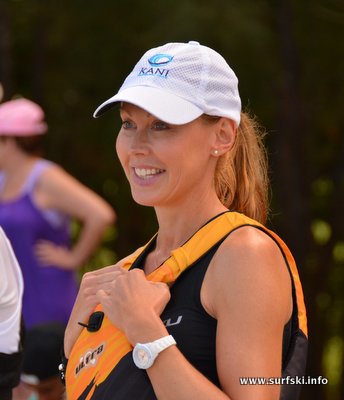
Test pilot Kassie "I always smile when I'm nervous" James before the start of the 2013 Mauritius Ocean Classic
I first sat on a surfski on 17 February 2013 (briefly… before falling off it… to be fair, it was a Glide). Prior to that I had paddled a chubby, and forgiving, 3.5m sit-on-top plastic for three months. Other than that… no paddling experience at all. I make this point because I have met so many people who tell me that they too are a beginner surfski paddler … but, oh yeah, they have done white water paddling for 12 years, or 23 years of sea kayaking… It’s. Not. The. Same … just sayin’…
A couple of stints in a double ski far far off the coast of Western Australia with Oscar Chalupsky and Dean Gardiner in the driver’s seat, and I was hooked on the exhilaration that is ocean paddling. Now there was just the minor challenge of having my skill catch up with my desire…
On a night soon after my return from Western Australia a plan was hatched… I would do the Mauritius Ocean Classic in June 2013. (It is theoretically possible there may have been some alcohol involved.)
And so began my immersion in ocean paddling… and in the ocean.
In the three-month lead–up to Mauritius I paddled a Fenn XT. In the Fenn range the XT sits between the Bluefin and the Swordfish… but more toward the Bluefin end of the spectrum.
For those not in the know, the XT is also classed as a beginner ski… but not a beginner-y as the Blue Fin (being 4 cm narrower and blah blah something about hull shape). Fenn describes the ski in these words: “Still a challenge for total novices but even without much experience paddlers will be able to master the surfski within hours.” This is Top Secret Marketing Speak for: “Total novices will do quite a bit of swimming initially”.
Paddling in Mauritius
Mauritius is a lovely tropical-ish (i.e it has the requisite palm trees and drinks with small umbrellas) island lassoed by a reef. Mauritius is a magnet for big swell and where the wind makes mischief.
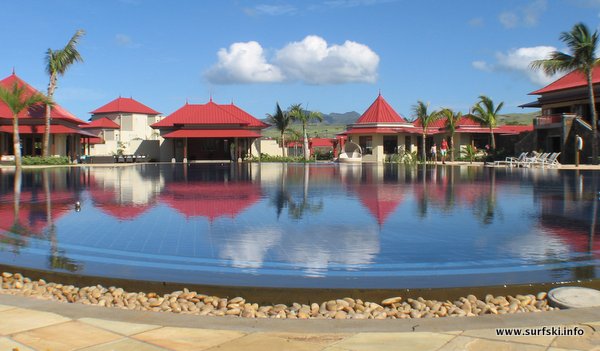
Tamassa Resort - luxurious beach living!
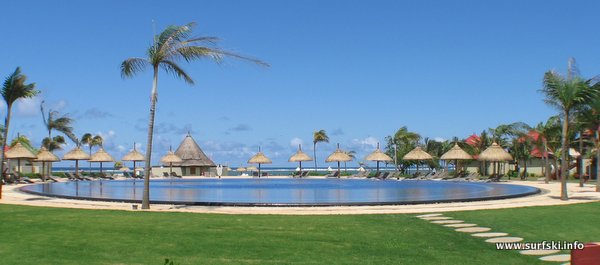
Palm trees, pools, ocean, waves, sun, cocktails, you get the idea.
The Mauritius Ocean Classic is based at the Tamassa Beach Resort at Bel Ombre. Everyone stays at the same hotel and, thus, there is much camaraderie (particularly given that alcohol is included in the package). It’s not just a race – there are several days of paddling and clinics before race day. The hotel is luxurious, the week seamlessly well run and the pace relaxed. The week runs on island time which means that a 10 am paddle will occur at some time between 11am and 1pm …ish. Your ski of choice is provided for you for the week by Fenn or Epic, for a very modest fee (which goes to form the prize pool).
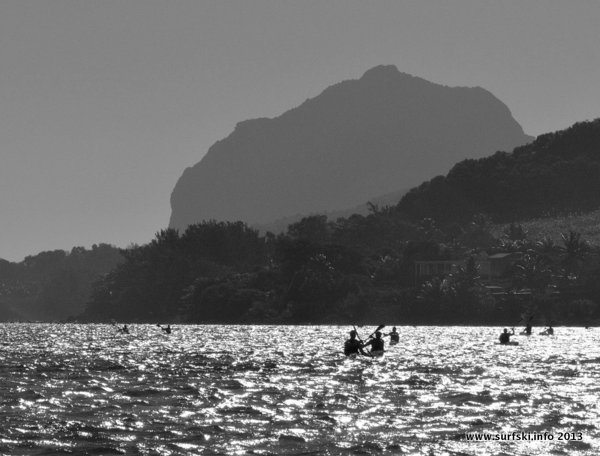
Mauritius truly is a stunning venue for paddling (Le Morne mountain the background)
On Day One skis are allocated – I had requested a Bluefin or an Epic V8 but, despite this, had been having nightmares about being allocated an Elite SL. It was an immense relief to spot - amongst the sea of almost 100 skis stretching across the manicured lawns - the wide hips of a Bluefin.
The plan for the Day One paddle was to paddle outside the reef to Le Morne Pass (the finish of the Race) – a distance of about 15 km. The wind was blowing 20 knots plus and the swell was around three metres with a 17 second period. Through some complex formula this meant there were waves of about 15 to 18 foot breaking on the reef. (Don’t ask me why swell is measured in metres and breaking waves (and runners) in feet – it’s a paddler thing I presume.)
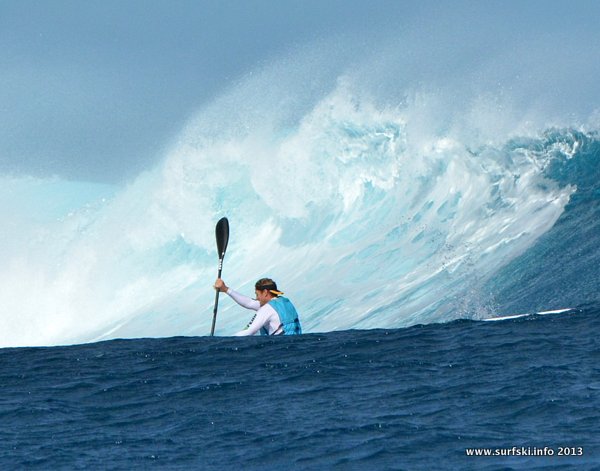
Hank McGregor tackles the wave at Le Morne
The only way to get outside the reef (aka Out.The. Back.) is through a handful of passes, which (for the non greased toothpick paddlers amongst us) are breaks in the reef. The passes run on the diagonal so are hard to spot. Basically a pass is really-churned-up-water-bookended-by-massive-waves. From Out. The. Back there are Very. Few. Ways. Back… essentially you can go through a pass (voluntary) or over the reef (involuntary). As a tip, one of these routes has a chance of ending better than the other.
The view from Out. The. Back. is of a wall of waves rearing up, roaring and monstering the land. Those less prone to demounts paddle closer to The Wall. Folk like I give it a minimum three-attempts-at-remount clearance window.
Once Out. The. Back there were runners of five to six feet to catch… and to the left a three metre side swell…. and to the right a 15 to 18 foot drop… oh, and the occasional random breaking wave, just to keep it interesting.
These conditions were bigger than those I had paddled in prior to the Race (aka EVER). The knowledge that to your right was a big drop was somewhat destabalising. Stability is not just about boat and body – there is also a head thing as well. And, if your head is wobbly, then so is your body. But if you trust your boat, well the head is less wobbly, and then so is the body … and, anyway, it’s circular… and probably far less complex than I am making out.
So… less about me, and more about the ski…
The Tuna was incredibly stable – I made it out through the pass without incident. Once Out. The. Back. (and once I had stopped shaking) I was able to catch (and even occasionally link – the lack of link being user error, not ski) runners. At times the ski caught runners I did not think I could catch. I don’t recall having to brace at any time.
Involuntary Dismount
I had one involuntary dismount Out the Back but to be fair to me (oh, and the ski) that was when a wave broke on us. I remounted in one attempt (once I had carried out appropriate negotiations with the leg rope). (As an aside, the ease of remount for a particular ski should not be overlooked as a key ski selection criteria for beginner paddlers. After three attempts at remounting, a paddler is significantly fatigued – not to mention rattled- and the likelihood of coming off again is greatly increased.) The stability of the Bluefin and the shallow bucket made it easy to remount, even in lumpy conditions.
Others did not fare so well. On Day One there were several paddlers who had 20 or 30 demounts, having attempted to paddle the ski they paddled at home. So well run was the event however, that there were sufficient skis available for them to move to more stable skis for the rest of the week.
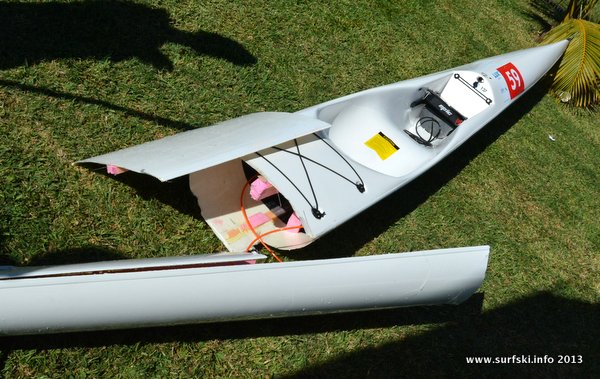
Some folks fared even less well than others - an ex-ski (although repairable)
I dismounted a second time when I broached the ski on a wave at Le Morne Pass (again, user error). It had been a party wave… until I wrecked the party… and I got to wear the ski as a hat in the drop zone for several waves. Again, a slick remount when the waves abated.
Day One provided the most testing conditions of the week for me. Day Two conditions were bigger but due to concerns about the passes closing out the organisers confined two-thirds of us to the lagoon.
Race Day
Race day conditions were a tame 8 to 10 knots of wind. In these flatter conditions I confess I missed the XT. I am fairly slight (at 170 cm and 58 kg) and the Bluefin is a lot of boat to move. To be fair, it was not a true apples-to-apples comparison as the Bluefin was the glass model and my XT is carbon.
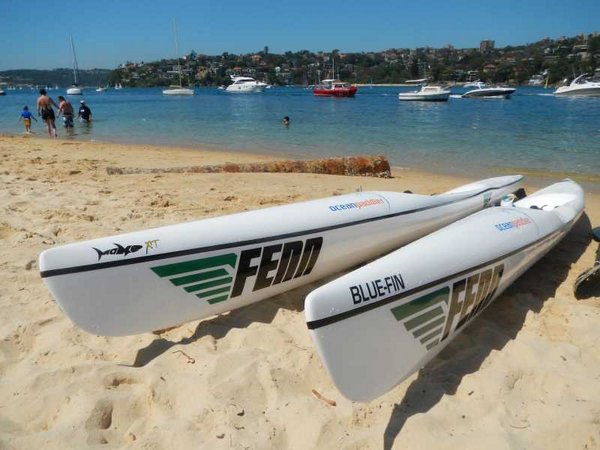
XT and Bluefin
I am often asked whether a beginner paddler should choose a Bluefin or an XT. My response: try both if at all possible, - but if you are smaller and find the XT reasonably stable (there will still be some swimming) then go with the XT. If you are bigger and stronger and/or stability is an issue then go with the Bluefin. Having said that – had I been on the XT on Day One in Mauritius I have no doubt that things would have become quite untidy (this is Top Secret Code for “I would probably have died.”) I still occasionally come off the XT in less challenging conditions than those I experienced in Mauritius (oh, and also when I attempt to remove my booties whilst on the ski…as you do...)
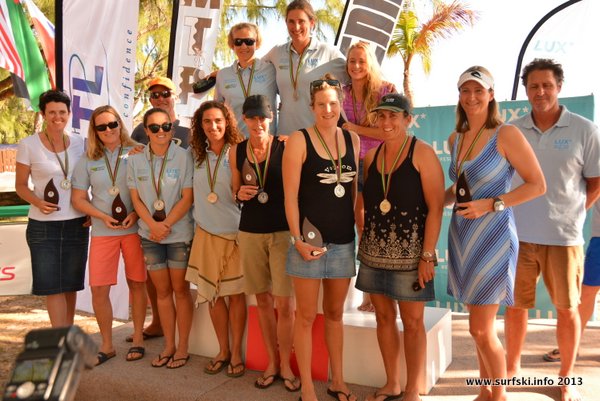
But hey, getting near the podium on the first try ain't bad!
The essence of the Bluefin
In summary then, the Bluefin has excellent primary and secondary stability… and it’s faster than an upside down Elite.

